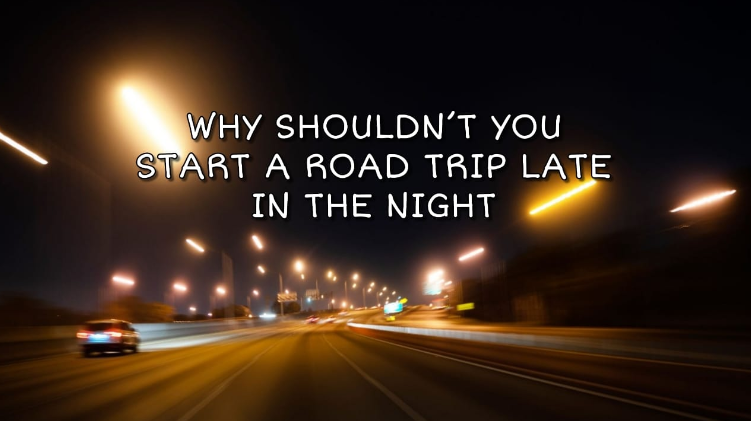Why Shouldn’t You Start a Road Trip Late in the Night?: Safety First

Starting a road trip late at night is unsafe due to reduced visibility and driver fatigue. It increases the risk of accidents and diminishes reaction times.
Embarking on a road trip is an adventure that requires careful planning and consideration for safety. Nighttime driving presents a unique set of challenges and hazards. Darkness affects depth perception and peripheral vision, making it harder to navigate unfamiliar roads and spot potential dangers.
The body’s natural sleep cycle also makes late-night hours a peak time for drowsiness, compromising the driver’s ability to remain alert and responsive. Safety should always be a top priority, and thus, avoiding the start of a journey when the sun sets is a wise decision. Early departures allow travelers to take full advantage of daylight, ensuring a safer and more enjoyable experience. Remember, the key to a memorable road trip lies in reaching your destination safely; this begins with a smart and bright start, not under the cloak of night.
Contents
Risks Of Nighttime Driving
The risks of Nighttime Driving become full force when the sun goes down. Exploring the open road by starlight may sound romantic, but starting a road trip late at night brings undeniable dangers. For those considering an after-dark departure, it’s crucial to understand the heightened hazards that can turn an adventure into a misadventure.
Lowered Visibility And Reaction Time
Driving at night means darker conditions and less visibility. With only headlights to rely on, depth perception, color recognition, and peripheral vision all suffer. This makes spotting potential problems far more difficult. Possible obstacles like animals, debris, or sudden turns become harder to see. Inevitable delays in driver reaction times can mean the difference between a safe trip and a serious accident.
- Bright signs can blind drivers temporarily.
- Tail lights ahead may need to give more warning for hazards.
- Headlight glare from oncoming traffic can be disorienting.
Fatigue can sneak up quickly on nighttime drivers. The body’s natural sleep rhythms tell us it’s time to rest, not time to embark on a journey. The dark, quiet road can lull a driver into drowsiness, leading to slowed reflexes or, worse, falling asleep behind the wheel.
| Time | Risk Level |
| 12 AM – 6 AM | Highest for fatigue accidents |
| After a long day | Increased drowsy driving |
Statistics show that night driving significantly increases accident risk. Drivers should weigh these risks before deciding to travel at night.
Dangers Of Drowsy Driving
Hitting the road late at night may seem thrilling, but it hides risks. Drowsy driving is one major concern. Your body craves sleep as it gets dark, and fighting this instinct can lead to dangers on the road.
Micro-sleeps Behind The Wheel
Micro-sleep is a brief, uncontrollable episode of sleep. This can last from a fraction of a second to several seconds.
- A driver might not even know they had a micro-sleep.
- Micro-sleeps can cause you to miss crucial signs or turns.
- Risks are high, especially when driving at high speeds.
A few seconds are enough for a vehicle to drift out of the lane. Accidents can occur before one realizes they dozed off.
Similarities To Drunk Driving
Lack of sleep affects the brain like alcohol does. It slows down reaction times and makes decision-making harder.
| Drunk Driving | Drowsy Driving |
| Impaired coordination | Similar effects of alcohol |
| Reduced ability to concentrate | Can’t focus well |
| Decreased reaction to stimuli | Slower reactions |
Both drunk and drowsy drivers pose serious threats on the road. Starting a trip well-rested is crucial.
Wildlife Hazards At Night
Embarking on a road trip as twilight fades might seem adventurous. Yet this decision brings unforeseen dangers, particularly wildlife hazards at night. Whether it’s the allure of nocturnal animals or the deceptive calm of the evening, the night conceals challenges that can transform an exciting journey into a risky venture.
Increased Animal Activity
Many animals are more active during the night. Deer, raccoons, and opossums thrive under the cover of darkness. They often search for food and water, crossing roads with little caution. Their unpredictable movements create an increased risk for drivers. During a nocturnal road trip, stay vigilant to spot these creatures.
Collision Risks With Nocturnal Creatures
- Vision is limited after dark.
- Animals’ reflective eyes can blind drivers.
- Reactions slow when unexpected animals appear.
When you drive late at night, the risk of colliding with nocturnal wildlife soars. Low visibility, paired with the swift appearance of animals on the road, leaves limited time for drivers to react. Boldly illuminated eyes can also startle and temporarily blind drivers, contributing to potential accidents.
| Animal | Activity Peak | Risk Description |
| Deer | Dusk to Dawn | High accident probability due to deer crossings. |
| Raccoons | Nighttime | Search for food can lead to unexpected road crossings. |
| Opossums | Nighttime | Slow-moving, creating collision risks. |
Distinguishing road hazards becomes arduous at night. Coupled with increased wildlife activity, this elevates the risks involved in embarking on a road trip after sunset. Therefore, planning your departure to avoid these nocturnal dangers is not only wise—it’s essential for safe travel.
Limited Access To Services
Imagine driving into the silent night. Stars guide you. Yet something’s absent—service stations. They often close after dark, which brings trouble.
Are you running low on fuel? Or do you need a quick snack? Think again. Fewer options await at night. Here’s why a nighttime road trip could land you in a pickle.
Many services shut at night. This could put a damper on your plans. Let’s explore the potential roadblocks you might face.
Closed Service Stations
Nighttime means lights out for many gas stations and convenience stores. This leaves travelers with a tank nearing empty, scrambling for a rare, open pit stop. Access to restrooms, hot drinks, or a safe spot to stretch your legs becomes a quest in itself.
- No gas station means no fuel.
- No convenience stores say goodbye to late-night snacks or caffeine boosts.
- There is no rest area, so prepare for a less comfy drive.
Emergency Assistance Challenges
Breakdowns are a driver’s nightmare, more so at night. Help is scarce in the moonlit hours. Whether you need a tow or a mechanic, expect delays. Helplines may operate with skeleton crews, adding to wait times.
| Service | Daytime Availability | Nighttime Availability |
| Tow Services | High | Low |
| Repairs | Good | Poor |
| Emergency Support | Accessible | Limited |
In an emergency, every minute counts. If you’re stuck waiting in the dark, those minutes can feel like hours.
Higher Crime Rates After Dark
Embarking on a road trip thrills many with the promise of adventure. Yet, traveling late into the night could lead to unforeseen risks, particularly regarding elevated crime rates after sunset. Understanding these risks is crucial for anyone passionate about hitting the road.
Vulnerability To Theft And Attacks
The cover of darkness often emboldens criminals. Statistics show a significant increase in theft and attacks at night. Setting out late could mean encountering thieves who capitalize on the reduced visibility and slower response times by law enforcement.
- Parked vehicles are easy targets for break-ins, especially when left unattended in remote areas.
- Driving through poorly lit streets raises the odds of personal encounters with criminals.
- Traffic checkpoints and services are scarce, resulting in slower assistance if an incident occurs.
Isolated Roads And Personal Safety
Not only are theft and attacks concerns, but personal safety also takes a hit on deserted roads. Solitude, while peaceful in daylight, transforms after dusk into a vulnerability.
| Consideration | Day | Night |
| Visibility | High | Low |
| Traffic | More Cars | Fewer Witnesses |
| Assistance | Readily Available | Hard to Find |
Roadside emergencies could leave you stranded and susceptible to hazards. Few passersby might mean longer waits and increased risks:
- Accidents can go unnoticed for extended periods, delaying critical aid.
- Breakdowns become more daunting when help is far and few.
Impact On Circadian Rhythms
Your body has a natural clock known as the circadian rhythm. It tells you when to stay awake and when to sleep. Taking a road trip late at night can throw this delicate balance into disarray. Let’s dive into how an untimely adventure can upset your body’s natural cycle.
Disruption Of Sleep Patterns
- Delayed Sleep Phase: Initiating a drive at night delays your bedtime.
- Irregular Sleep Hours: Unexpected stops can interrupt sleep further.
- Reduced Sleep Quality: Sleeping in a vehicle rarely matches your bed at home.
Consistent bedtimes are crucial for health. Late trips jeopardize this.
Effects On Next-day Alertness
Sleeping less due to a nighttime drive affects you the next day. Driving alertness drops, raising the risk of accidents. Concentration suffers during the day.
- Mood Swings: Expect irritability and low patience.
- Memory Issues: Lack of rest impedes memory consolidation.
- Motor Skills: Your coordination and reaction times could falter.
Embarking on a road trip can ignite a sense of adventure unlike any other, but setting off late into the night introduces an array of challenges, especially when it comes to navigational difficulties. Darkness obscures landmarks and signage, amplifying the potential for getting lost and turning your smooth drive into a frustrating experience. In the following sections, we’ll explore why starting your journey under the veil of night could lead you astray.
Challenges Finding Your Way
As the cloak of night descends, so does your ability to spot crucial navigational cues. Highways that seem straightforward by day become labyrinths at night. This can lead to missed turns and confusing intersections, with no daylight to guide you. Darkness masks the visual aids, such as landmarks or unique terrain features that can be essential for a successful trip. These visual guides often serve as checkpoints that ensure you’re still on the right path.
| Day Navigation | Night Navigation |
| Clear visibility | Limited visibility |
| Visible landmarks | Obscured landmarks |
| Readable signage | Hard-to-spot signs |
Reliance On GPS and Potential Errors
GPS devices have transformed travel, offering routes at our fingertips. Still, they need to be foolproof. Signal loss is more troublesome during nighttime adventures. Cliff drop-offs, unpaved roads, or recent changes in traffic patterns can lead to hazardous misdirection. Additionally, the absence of sunlight makes it harder to recognize GPS errors before it’s too late to take corrective action.
- Common GPS glitches:
- Signal dropouts in remote areas
- Outdated maps
- Incorrect routing
- Delayed updates on road closures
Tips For Safer Night Travel
Embarking on a road trip as night falls could be exciting, but it’s rife with challenges. Reduced visibility and fatigue are major concerns. Consider these strategies to navigate the night safely.
Best Practices For Nighttime Driving
Keep your eyes on the road and stay alert to your surroundings. A clear windscreen and clean headlights improve visibility. Take frequent breaks to avoid fatigue. Use night mode on dash displays to reduce glare. Adjust your driving speed to maintain a safe stopping distance.
- Check vehicle lights before heading out.
- Avoid staring at oncoming headlights.
- Plan routes with well-lit roads and rest stops.
When To Consider Delaying The Trip
Bad weather, such as heavy rain or fog, calls for caution—delay trips when visibility is poor. Drowsiness impairs driving; rest well before departing. Recognize your limits and postpone the trip if you feel too tired.
| Condition | Action |
| Severe Weather | Delay until clear |
| Fatigue | Rest before driving |
| Poor Visibility | Wait for daylight |
Conclusion
Embarking on a late-night road trip might seem thrilling, but the risks are significant. Reduced visibility, driver fatigue, and limited access to services are considerable safety concerns. Opt for an early morning start to ensure a safer, more enjoyable journey.


